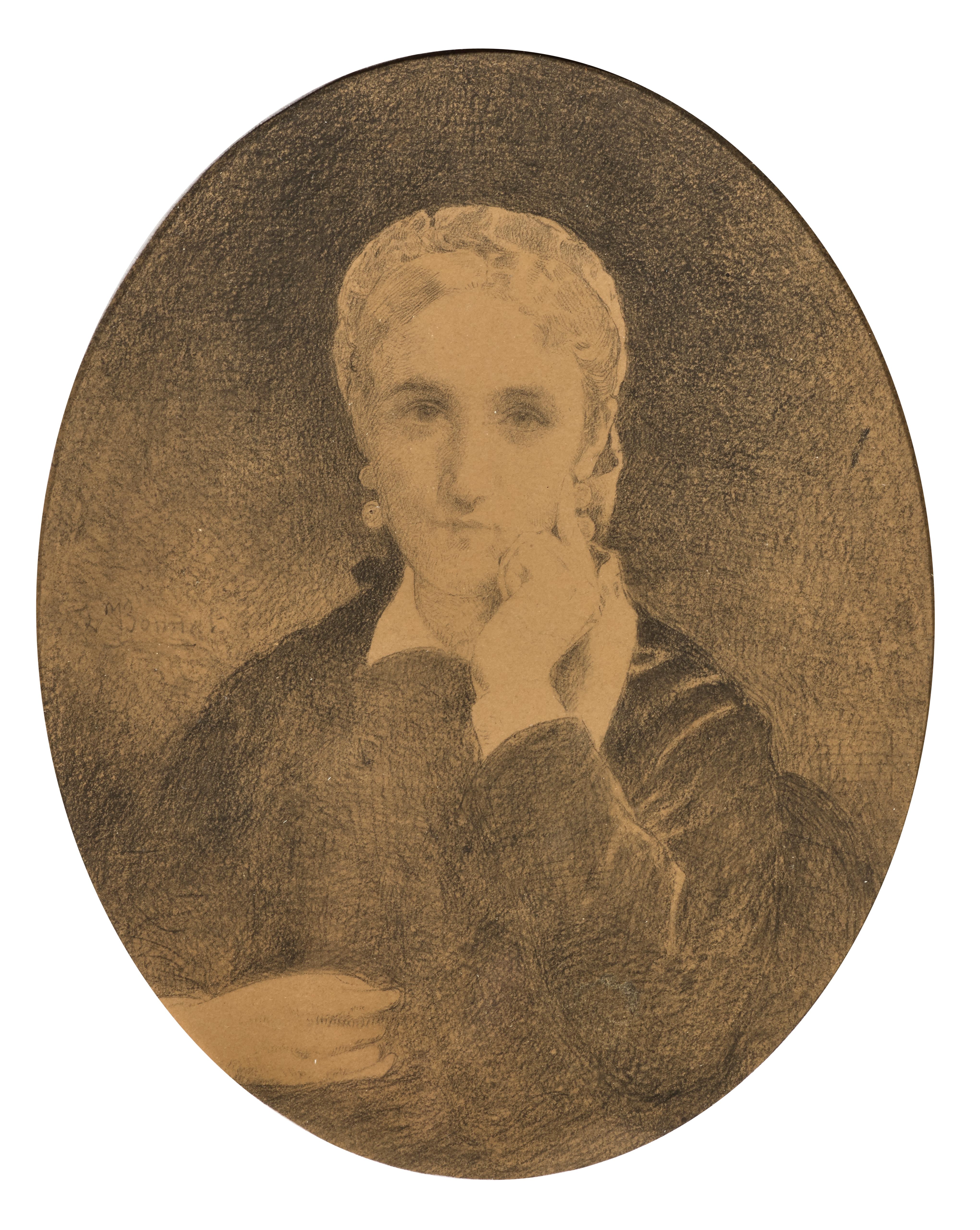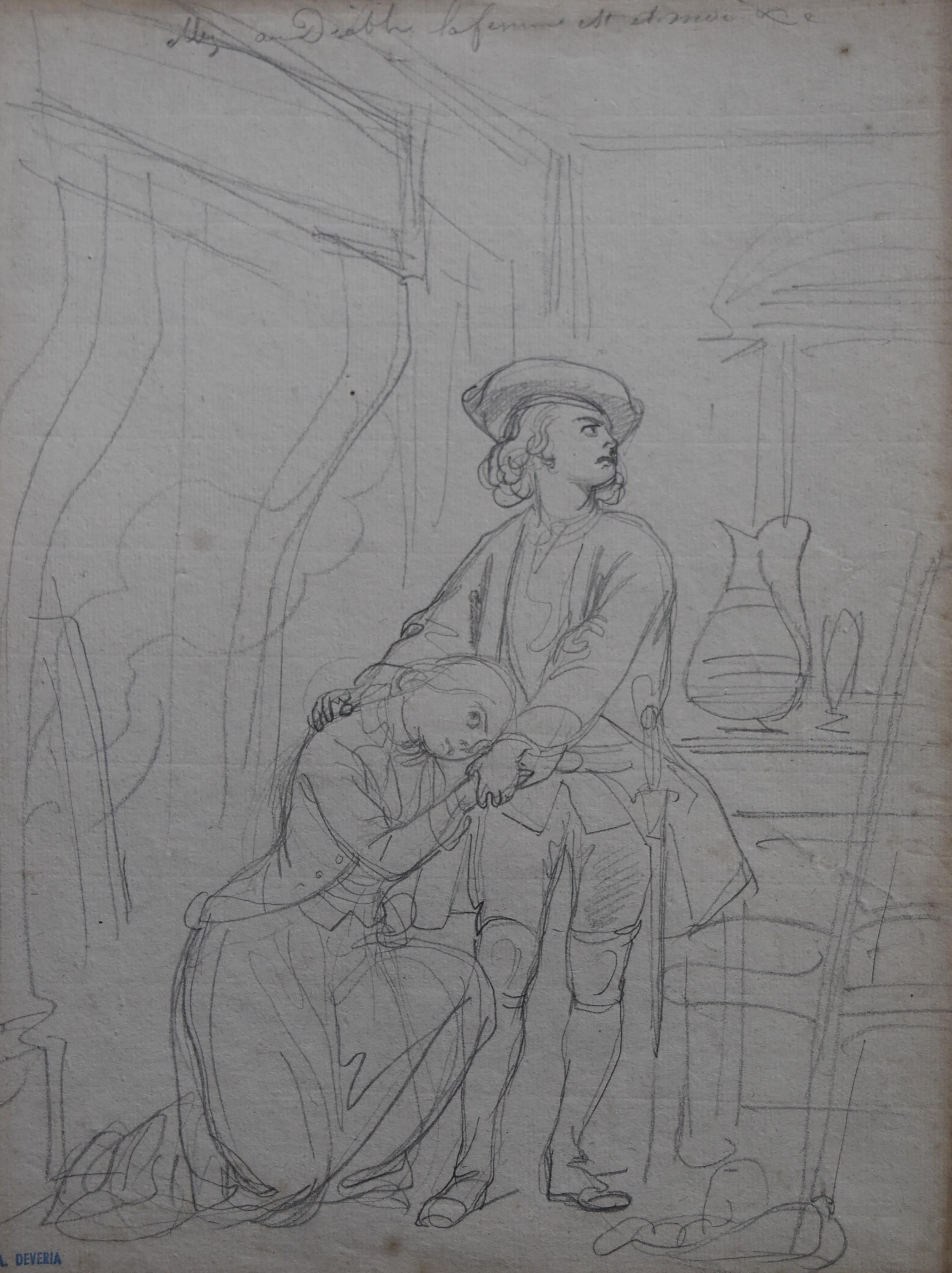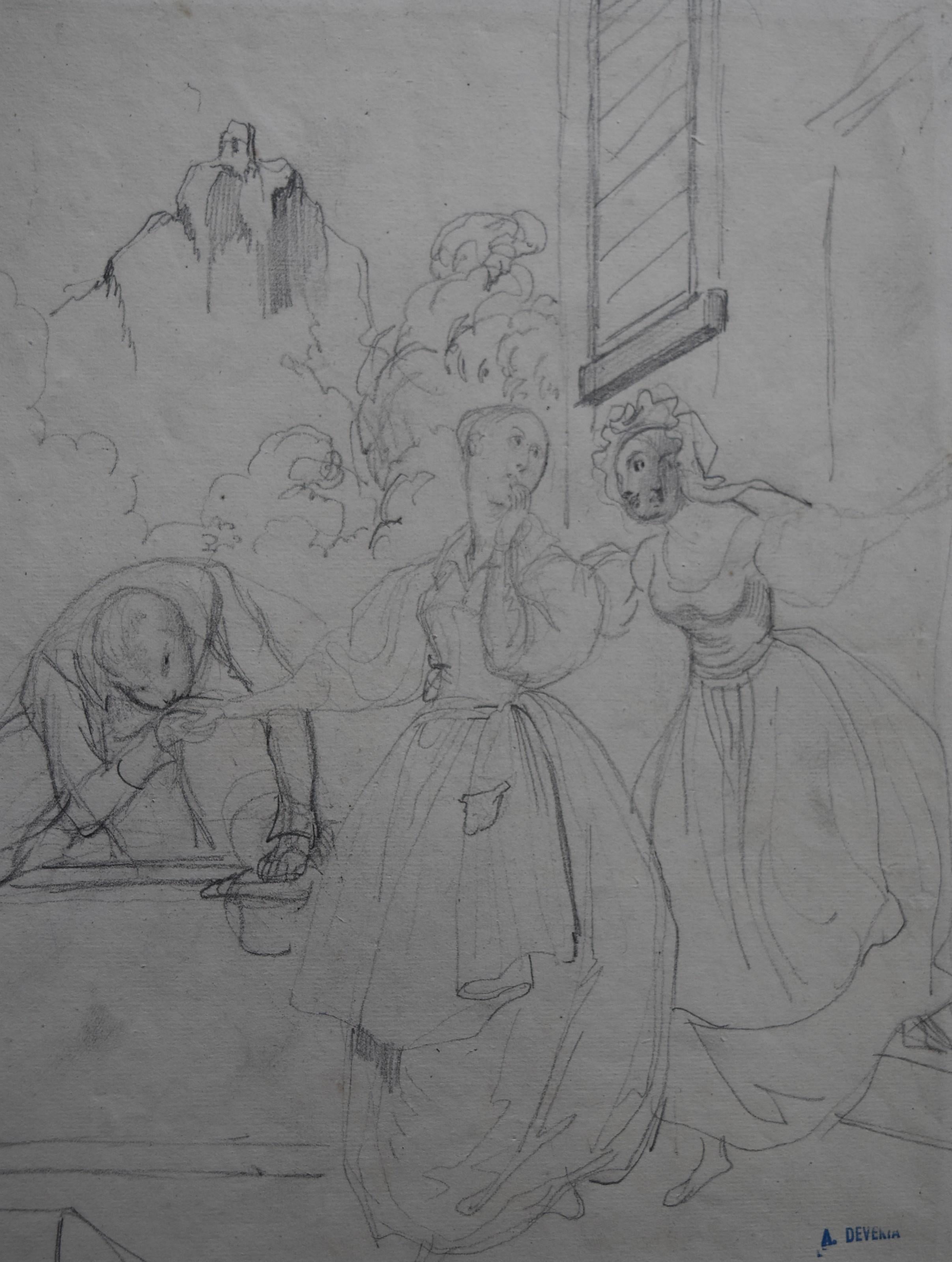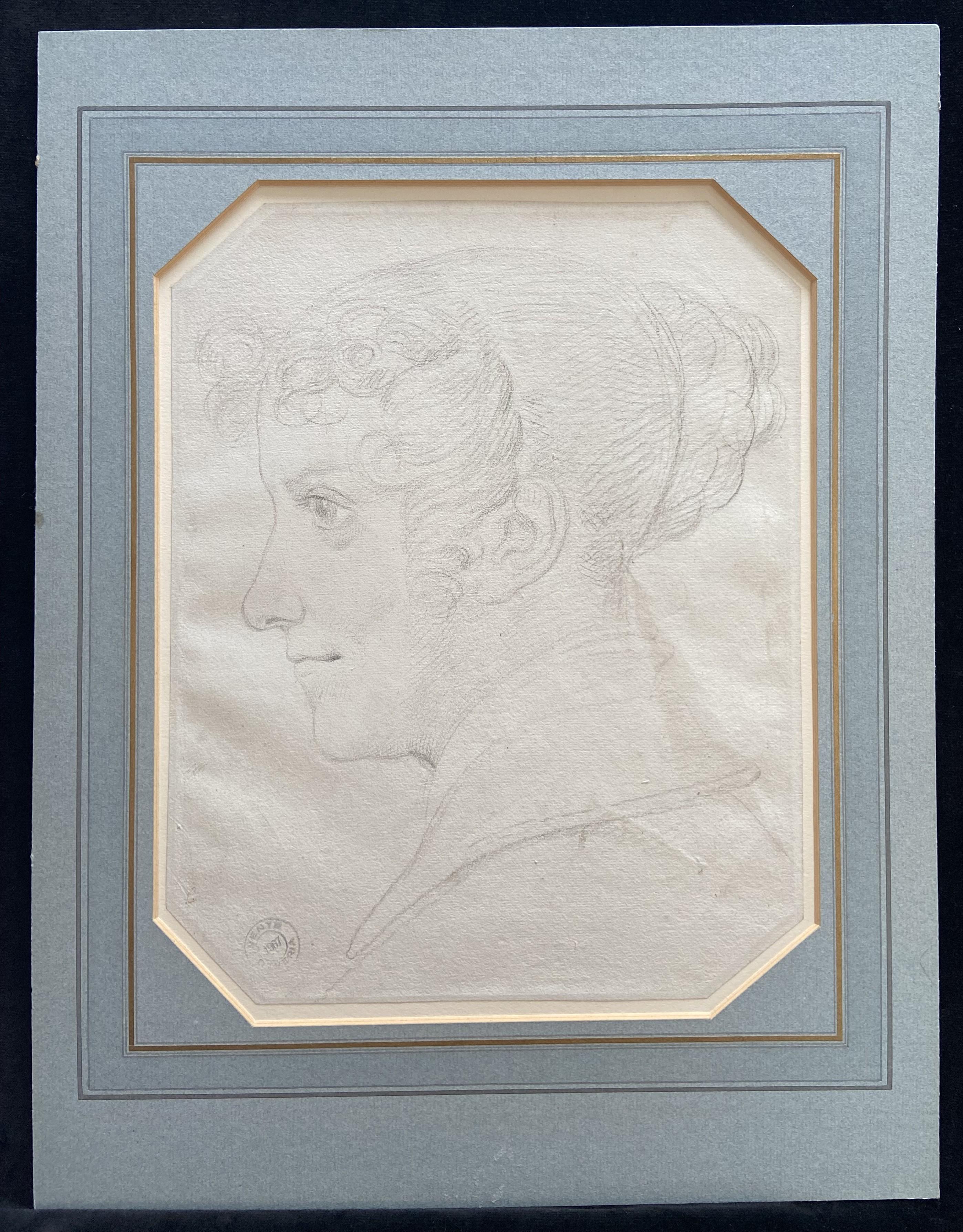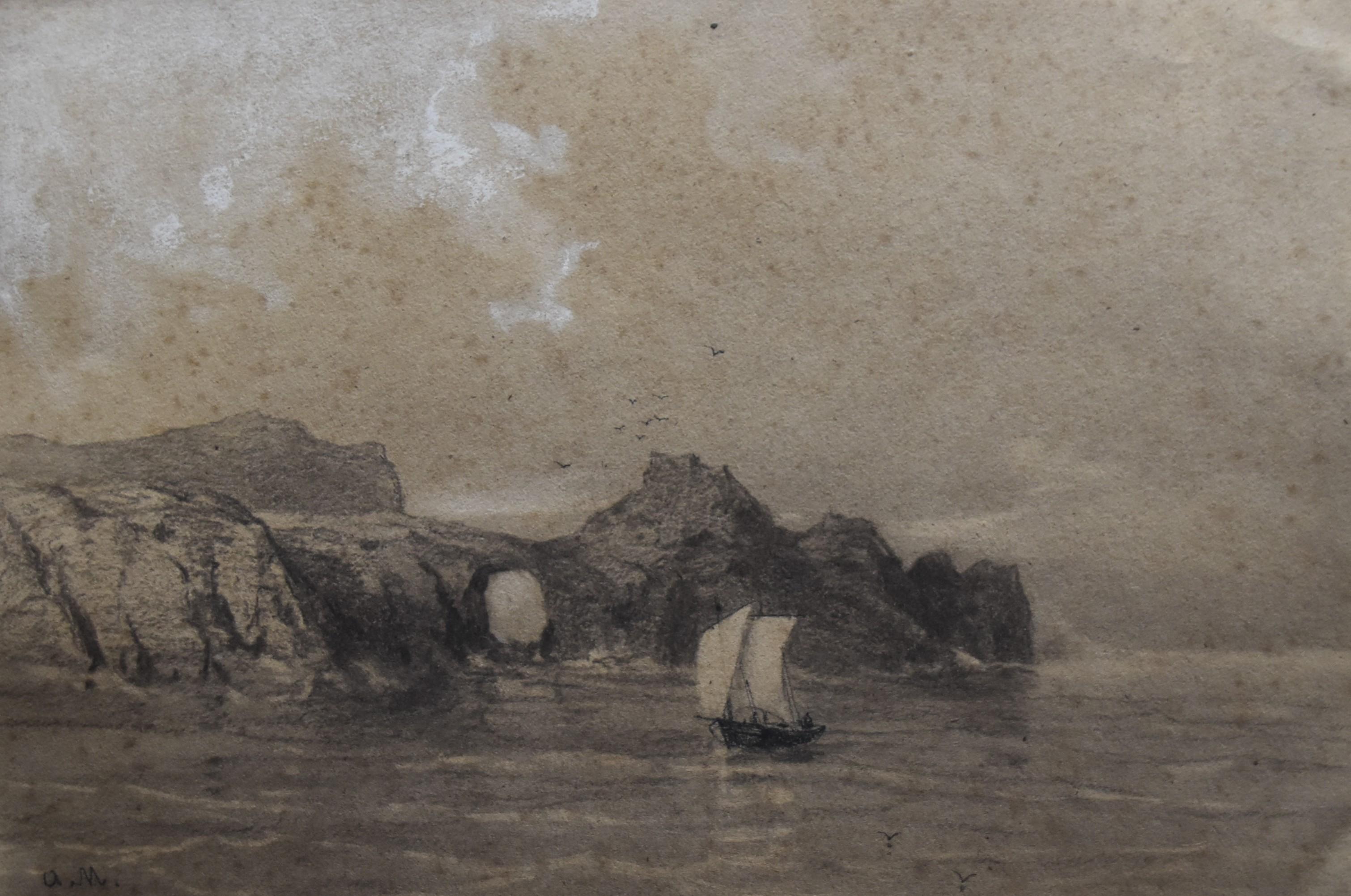Items Similar to Charles Emile Jacque (Paris 1813 - 1894) Dog in a doghouse, signed drawing
Video Loading
Want more images or videos?
Request additional images or videos from the seller
1 of 10
Charles JacqueCharles Emile Jacque (Paris 1813 - 1894) Dog in a doghouse, signed drawingcirca 1860
circa 1860
About the Item
Charles Emile Jacque (1813-1894)
Dog in a doghouse
Monogrammed "C. J. "lower right
Pencil on paper
17 x 13 cm
Mark of the Collection of Doctor Albert Finot "AF" (Lugt 3627) lower left
Vintage mount, morden frame 33 x 29.5 cm
Provenance :
Albert Finot Collection
Private collection, South West France
Charles Jacque had a particular fondness for animals, which he often drew and painted. He often drew and painted sheep, and sometimes other farm animals, so this true portrait of a dog is particularly interesting.
He drew not just a dog in the doghouse, but a real genre scene: the little dog has caught its paw in the chain to which it is tied and seems to be calling for help to be rescued.
It's a very accomplished and endearing piece of work.
Charles-Émile Jacque (23 May 1813 – 7 May 1894) was a French painter of Pastoralism and engraver who was, with Jean-François Millet, part of the Barbizon School.
He was part of the first generation of painters to leave Paris for Barbizon and the forest of Fontainebleau.
Charles Jacque was also a founding and influential member of the “Men of 1830” (also called l’Ecole francaise du paysage), an artistic movement who, spurred on by the Revolution of 1830, sought out new directions in landscape painting. His strong, realistic, yet sensitive depictions of shepherds and their flocks form one of the most cohesive and important bodies of work produced by the movement.
During the 1840s, he and his friend, Jean-Francois Millet moved to the village of Barbizon where they felt they could more realistically portray nature. Jacque bought a house there and, influenced by Narcisse Diaz’s technique and Francisque Millet’s themes, he found his inspiration in hen-houses, pigsties and flocks of sheep at pasture.. He left Barbizon in 1854 and continued to paint in the outskirts of Paris until he died on May 7, 1894.
Works by his hand are held by numerous museums such as
Baltimore Museum of Art, Isabella Stewart Gardner Museum, in Boston, Cincinnati Museum of Fine Art, Edinburgh, National Gallery of Scotland, Glasgow Museum of Art, Kansas City, Minneapolis Institute of Arts, Metropolitan Museum of Artin New York, Ashmolean Museum, Oxford University, Philadelphia Museum of Art and of course at the Musée du Louvre and Musée d’Orsay in Paris
- Creator:Charles Jacque (1813 - 1894, French)
- Creation Year:circa 1860
- Dimensions:Height: 6.7 in (17 cm)Width: 5.12 in (13 cm)
- Medium:
- Movement & Style:
- Period:
- Condition:
- Gallery Location:Paris, FR
- Reference Number:
About the Seller
5.0
Platinum Seller
These expertly vetted sellers are 1stDibs' most experienced sellers and are rated highest by our customers.
Established in 2018
1stDibs seller since 2019
210 sales on 1stDibs
Typical response time: <1 hour
- ShippingRetrieving quote...Ships From: Paris, France
- Return PolicyA return for this item may be initiated within 14 days of delivery.
More From This SellerView All
- French school of the nineteenth century, LW (?) Harbor scene, drawing signedLocated in Paris, FRFrench school of the nineteenth century, LW (?) Harbor scene, animation around a skiff Pencil on paper Signed LW (?) Bottom right 15 x 21 cm Framed : 27 x 34.5 cm This very fine ...Category
1840s Romantic Landscape Drawings and Watercolors
MaterialsCarbon Pencil
- Achille Devéria (1800-1857) Allez au diable, la fille est à moi Original DrawingLocated in Paris, FRAchille Devéria (1800-1857) "Allez au diable, la femme est à moi" (Go to hell, This woman is mine) pencil on paper annotated on the upper border "Alle...Category
1850s Romantic Figurative Drawings and Watercolors
MaterialsCarbon Pencil
- Achille Devéria (1800-1857) A galant scene Original DrawingLocated in Paris, FRAchille Devéria (1800-1857) A galant scene pencil on paper Some stains (see photographs please) Bears the stamp of the Achille Deveria Estate Sale o...Category
1850s Romantic Figurative Drawings and Watercolors
MaterialsCarbon Pencil
- Achille Devéria (1800-1857) A young woman seen in profile, original drawingLocated in Paris, FRAchille Devéria (1800-1857) A young woman seen in profile Black Chalk on paper with cut edges Bears the stamp of the Achille Deveria Estate Sale of 1...Category
1840s Romantic Portrait Drawings and Watercolors
MaterialsCarbon Pencil
- Auguste Mayer (1805-1890) A seascape with a boat, signed drawingLocated in Paris, FRAuguste Mayer (1803-1890 A seascape with a boat signed with the initials on the lower left Pencil and heightenings of white gouache on paper 17.5 x 26 cm In fairly good condition, ma...Category
1860s Romantic Landscape Drawings and Watercolors
MaterialsCarbon Pencil, Gouache
- Pierre-Georges Jeanniot (1848–1934), Henri Rochefort for a duel, drawingBy Pierre Georges JeanniotLocated in Paris, FRPierre-Georges Jeanniot (1848–1934) Portrait of Henri Rochefort ready for a duel, Pencil on paper Signed and titled lower left 28 x 21 cm In good condition : the left and right bord...Category
1870s Romantic Portrait Drawings and Watercolors
MaterialsCarbon Pencil
You May Also Like
- Portrait of a Melancholic Woman, a Drawing signed by Léon BonnatLocated in PARIS, FRThis drawing by Léon Bonnat, the greatest portrait painter of the Third Republic, shows a woman of indeterminate age, caught in a melancholic pose. 1. Léo...Category
Late 19th Century Romantic Portrait Drawings and Watercolors
MaterialsCardboard, Carbon Pencil
- Antique Horse "Heads, Hooves, Rump 1838" Wouterus Verschuur (Dutch, 1812-1874)Located in SANTA FE, NMAntique Horse Study "Heads, Hooves and Rump, 1838" Wouterus Verschuur (Dutch, 1812-1874) Pencil on paper Signed and Dated "W Verschuuur 1838" 10 x 6 1/2 (17 1/2 x 14 frame) inches In his time Wouterus Verschuur was an acclaimed and celebrated painter of horses. Through careful observation he learned to capture their physique and movement to perfection. As a true-born romanticist he was also interested in their character, thereby painting powerful carthorses in their stable, thoroughbred saddled horses during an afternoon ride or harnessed horses in action. He was born to an Amsterdam jeweler and received his training from the landscape and cattle painters Pieter Gerardus van Os and Cornelis Steffelaar. As part of this education Verschuur had to copy works by the 17th century painter Philips Wouwerman. Like Wouwerman, Verschuur's subjects consist mostly of stable scenes, landscapes with horses and coastal landscape. These works reflect the enduring influence of the northern Baroque masters on nineteenth century art, revealing the artist's close study of his Dutch and Flemish predecessors harking back to Peter Paul Rubens. Showing talent from a very early age, at 15 Verschuur had a painting exhibited at the "Exhibition of Living Masters" at Amsterdam in 1828. In 1832 and 1833 he won the gold medal at the annual exhibition at Felix Meritis. In 1833 he was appointed a member of the Royal Academy in Amsterdam. In 1839 he joined the artists' society, Arti et Amicitiae. His reputation was also considerable abroad. He was often featured in the annual exhibitions which travelled the large European cities at that time. In 1855 Napoleon III purchased one of his paintings at the Exposition Universelle* in Paris. The Verschuur horse revels in its physicality, like a quintessential Baroque horse...Category
1830s Romantic Animal Drawings and Watercolors
MaterialsPencil, Paper
- Antique Horse Study; Legs and Rumps, 1838" Wouterus Verschuur (Dutch, 1812-1874)Located in SANTA FE, NMAntique Horse Study "Legs and Rumps, 1838" Wouterus Verschuur l (Dutch, 1812-1874) Pencil on paper Signed and Dated "W Verschuur 1838" 10 x 6 1/2 (17 1/2 x 14 frame) inches In his time Wouterus Verschuur was an acclaimed and celebrated painter of horses. Through careful observation he learned to capture their physique and movement to perfection. As a true-born romanticist he was also interested in their character, thereby painting powerful carthorses in their stable, thoroughbred saddled horses during an afternoon ride or harnessed horses in action. He was born to an Amsterdam jeweler and received his training from the landscape and cattle painters Pieter Gerardus van Os and Cornelis Steffelaar. As part of this education Verschuur had to copy works by the 17th century painter Philips Wouwerman. Like Wouwerman, Verschuur's subjects consist mostly of stable scenes, landscapes with horses and coastal landscape. These works reflect the enduring influence of the northern Baroque masters on nineteenth century art, revealing the artist's close study of his Dutch and Flemish predecessors harking back to Peter Paul Rubens. Showing talent from a very early age, at 15 Verschuur had a painting exhibited at the "Exhibition of Living Masters" at Amsterdam in 1828. In 1832 and 1833 he won the gold medal at the annual exhibition at Felix Meritis. In 1833 he was appointed a member of the Royal Academy in Amsterdam. In 1839 he joined the artists' society, Arti et Amicitiae. His reputation was also considerable abroad. He was often featured in the annual exhibitions which travelled the large European cities at that time. In 1855 Napoleon III purchased one of his paintings at the Exposition Universelle in Paris. The Verschuur horse revels in its physicality, like a quintessential Baroque horse...Category
1830s Romantic Animal Drawings and Watercolors
MaterialsPencil, Paper
- Follower of Francis Wheatley, 19th century portrait of young maiden with flowersBy Francis WheatleyLocated in Harkstead, GBA really charming, early 19th century portrait of a young maiden carrying a basket of flowers. The face is beautifully painted with a slight blush to her cheeks and striking touches ...Category
Early 19th Century Romantic Figurative Drawings and Watercolors
MaterialsWatercolor, Paper, Pencil
- Studies of a statue and a sketch of a lady in inkBy George RichmondLocated in Petworth, West SussexGeorge Richmond RA (British, 1809 – 1896) Studies of a statue and a sketch of a lady in ink Pencil on paper and pen 6.7/8 x 9.3/4in. (17.5 x 25 cm.) Provenance: Abbot and Holder and Moore Gwyn Fine Art George Richmond was an English painter and portraitist. In his youth he was a member of the Ancients, a group of followers of William Blake. He was a keen follower or cricket, always to be found at Lords. He was a long life friend of Samuel Palmer and was a fellow student of Edward Calvert and Thomas Sidney Cooper. In 1888 Richmond went to Paris to study art and anatomy, it is possible this is from that period. His later works are portraits or prominent figures of the day such as William Wilberforce. He is buried at Highgate Cementary. Perhaps his most famous painting is a portrait of Charlotte Bronte...Category
19th Century Romantic Figurative Drawings and Watercolors
MaterialsPaper, Pen, Pencil
- Romantic Couple In Wartime Paris on Rainy Parisian NightLocated in Miami, FLThe technique and subject matter work well together in this loosely but masterfully rendered World War 1 romantic illustration of a Soldier and a Parisian woman. Even though this wo...Category
1930s Romantic Figurative Drawings and Watercolors
MaterialsInk, Watercolor, Pencil
